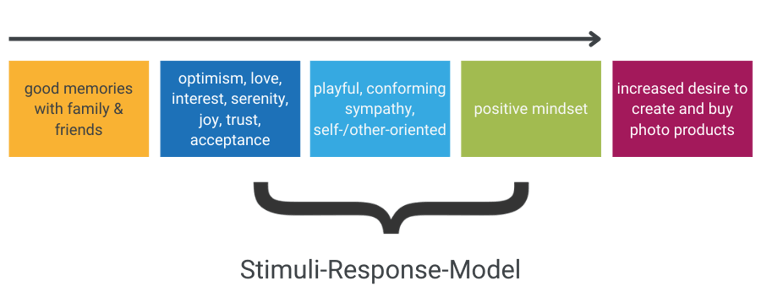4 min read
How to Boost Your Marketing with AI
Aug 5, 2021

Every buying decision is made on the base of emotions. Therefore, good marketing cannot be managed without knowing a customer's feelings connected with a brand, product or service. Photo business is not an exception! In fact, photo business brings along an extraordinary emotional buying process. This is why we want to take a look at the photo product creation related S-O-R-Model (Stimuli-Organism-Response), which shows what’s going on inside the consumer during the creation process.
How to make a consumers’ mind visible
While the S-R-Model (Stimuli-Response-Model) says that a consumers’ decision will always be the same when setting the same trigger, the S-O-R-Model additionally considers the consumers’ black box. The black box basically contains the consumers’ emotions, motivation and attitude towards a product, brand or service and actually shows the individuality of decision-making.

The S-O-R-Model developed out of the prior S-R-Model
To visualize the consumers’ black box in the world of photo book creation, ip.labs, the world’s leading photo software provider, commissioned an appropriate study that researched the consumers' emotion with the practice of intense focus groups.
The triggers of photo book creation
Creating individualized photo products is a highly complex and time-consuming process, necessarily connected with searching through someone’s photos. Since photos go hand in hand with memories, they also never go without emotions. Just think of a mom creating a photo book about a family holiday in Spain. The woman will at least, but not only, feel love, trust and joy, when seeing her kids play at the beach. Or, when seeing pictures of the family enjoying the sea, she will also feel a special sense of freedom. And this is only a sneak peek, what an emotional trip creating a photo product is. But this already shows us what triggers the consumer to create a photo book: good memories with family and friends (mostly, but not only, experienced in nature) that they want to hold on to in a haptic format. Actually, quality time is the most important stimuli to create a photo product.
Emotions during an average photo book creation process
Further the study showed, that as soon as the consumer decides to create a digital photo book, the memories plus the complex technical process lead to a huge range of emotions, that you might haven't known your brand, product or service was connected to:
- Optimism,
- Love,
- Interest,
- Serenity,
- Joy,
- Acceptance,
- Trust,
but also, to:
- Apprehension,
- Awe,
- Disapproval,
- Pensiveness,
- Contempt,
- Anger,
- Rage.
While the positive emotions develop out of different reasons, the most interesting outcome of this study is the only reason for the negative emotions: none-user-friendly technology! It was proven that consumers love everything about creating photo books, but are only disturbed by complicated technology. Indeed, the focus groups showed intense emotional breakouts when talking about that issue.
How to overcome negative emotions
There is no silver bullet in marketing science that shows us how to eliminate negative emotions. But in photo product creation, we can: Because negative emotions are completely connected to the technology, ip.labs only needs to eliminate the complexity of the software. How can we do that?
It might not be obvious at first glance, but Artificial Intelligence (AI) is already all around us. By integrating AI in the whole process of photo book creation, we could spare the consumer from being forced to confront his negative emotions.
ip.labs recognized this challenge quite early and is working on smart solutions. AI curated workflows e.g. built-in in our mobile apps aim at catching the consumer right at the place he takes his photos and takes over the whole photo product creation process by one click.
This way, negative emotions caused by technology are all taken away by technology.
After achieving this, you can now easily boost your brand, by focusing on the consumers’ positive emotions. Just pick the best fitting emotion (optimism, love, interest, serenity, joy, acceptance or trust) regarding your target group or buyer persona to make the consumer feel all positive about your business.
The way AI changes the consumers' motivation
Regarding the S-O-R-Modell, emotions always lead to motivation.
By eliminating negative emotions, the positive ones will delight the consumer to be highly motivated. Instead of seeing the photo product creation process as a strenuous task with a barely reachable aim, they will enjoy the creation process. Instead of feeling the urge of revolting against the software, they want to cooperate with it.
In general, the consumer is always motivated to create a photo book either by their inner wish to have someone’s own memories safely printed, or by wanting to bring joy for a friend or family member, when creating the product as a present.
Scientifically the consumer is now described as playfully, conforming a sympathetic motivated, sometimes spirited by oneself and sometimes generously for others.
How to change the consumer’s mind to boost your photo business
To come to the last point of the S-O-R-Model let’s have a look at how those positive emotions and motivational targets will change the customers’ mindset. To change the consumers’ attitude towards ones’ product, brand or service is the most interesting part of humans' organism in one place, but also it is the most difficult part to reveal. ip.labs’ study has shown that the customers are just waiting on this revolution in photo creation technology. Because of this crucial step, connected with the remaining positive emotions and motivation, the customers’ mind will be opened: By using highly sophisticated yet simple and user-friendly software in order to create photo products they are now open-minded to see photo product creation in a new and positive way in the long term.

This is the final step and simultaneously the base to create the response (R) a photo business wants: because a positive attitude always leads to a huge connection with a brand, product or service, and therefore it also leads to a significant raise of buying decisions and an increased turn over.
This blog post was written by Filzen, I. (2020). Social Media-Detox als Trend im Social Media-Marketing nutzbar machen (master thesis).
Topics: AI
Written by ip.labs
In rare cases we cannot show you the author of a blog post (e.g. if the content was written by more than one member of our crew). But we want our readers to know that everything published in our blogs is carefully crafted, checked and published by our team.



